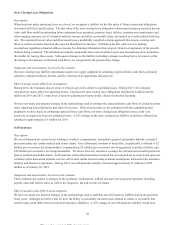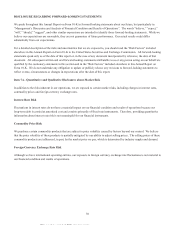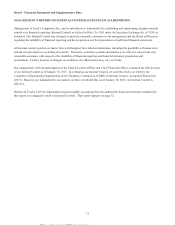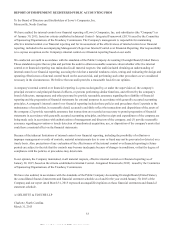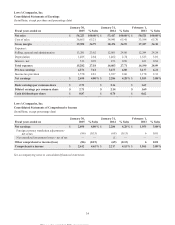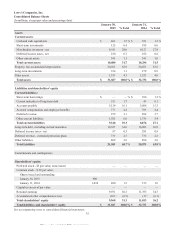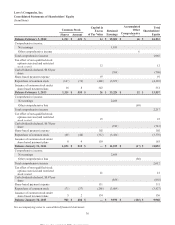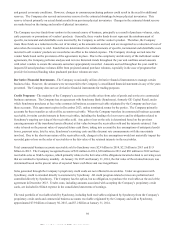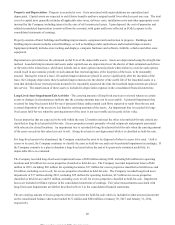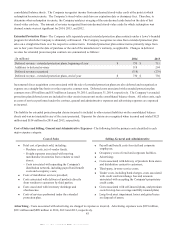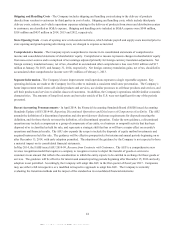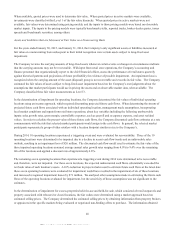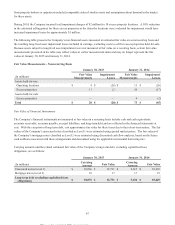Lowe's 2014 Annual Report Download - page 48
Download and view the complete annual report
Please find page 48 of the 2014 Lowe's annual report below. You can navigate through the pages in the report by either clicking on the pages listed below, or by using the keyword search tool below to find specific information within the annual report.NOTES TO CONSOLIDATED FINANCIAL STATEMENTS
YEARS ENDED JANUARY 30, 2015, JANUARY 31, 2014 AND FEBRUARY 1, 2013
NOTE 1: Summary of Significant Accounting Policies
Lowe’s Companies, Inc. and subsidiaries (the Company) is the world's second-largest home improvement retailer and operated
1,840 stores in the United States, Canada and Mexico at January 30, 2015. Below are those accounting policies considered by
the Company to be significant.
Fiscal Year - The Company’s fiscal year ends on the Friday nearest the end of January. Each of the fiscal years presented
contained 52 weeks. All references herein for the years 2014, 2013 and 2012 represent the fiscal years ended January 30, 2015,
January 31, 2014, and February 1, 2013, respectively.
Principles of Consolidation - The consolidated financial statements include the accounts of the Company and its wholly-
owned or controlled operating subsidiaries. All intercompany accounts and transactions have been eliminated.
Foreign Currency - The functional currencies of the Company’s international subsidiaries are generally the local currencies of
the countries in which the subsidiaries are located. Foreign currency denominated assets and liabilities are translated into U.S.
dollars using the exchange rates in effect at the consolidated balance sheet date. Results of operations and cash flows are
translated using the average exchange rates throughout the period. The effect of exchange rate fluctuations on translation of
assets and liabilities is included as a component of shareholders' equity in accumulated other comprehensive loss. Gains and
losses from foreign currency transactions, which are included in selling, general and administrative (SG&A) expense, have not
been significant.
Use of Estimates - The preparation of the Company’s financial statements in accordance with accounting principles generally
accepted in the United States of America requires management to make estimates that affect the reported amounts of assets,
liabilities, sales and expenses, and related disclosures of contingent assets and liabilities. The Company bases these estimates
on historical results and various other assumptions believed to be reasonable, all of which form the basis for making estimates
concerning the carrying values of assets and liabilities that are not readily available from other sources. Actual results may
differ from these estimates.
Cash and Cash Equivalents - Cash and cash equivalents include cash on hand, demand deposits and short-term investments
with original maturities of three months or less when purchased. Cash and cash equivalents are carried at amortized cost on the
consolidated balance sheets. The majority of payments due from financial institutions for the settlement of credit card and
debit card transactions process within two business days and are, therefore, classified as cash and cash equivalents.
Investments - As of January 30, 2015, investments consisted primarily of money market funds, municipal obligations,
certificates of deposit, and municipal floating rate obligations. The Company classifies as investments restricted balances
primarily pledged as collateral for the Company's extended protection plan program. Investments, exclusive of cash
equivalents, with a stated maturity date of one year or less from the balance sheet date or that are expected to be used in current
operations, are classified as short-term investments. All other investments are classified as long-term.
Merchandise Inventory - Inventory is stated at the lower of cost or market using the first-in, first-out method of inventory
accounting. The cost of inventory also includes certain costs associated with the preparation of inventory for resale, including
distribution center costs, and is net of vendor funds.
The Company records an inventory reserve for the anticipated loss associated with selling inventories below cost. This reserve
is based on management’s current knowledge with respect to inventory levels, sales trends and historical
experience. Management does not believe the Company’s merchandise inventories are subject to significant risk of
obsolescence in the near term, and management has the ability to adjust purchasing practices based on anticipated sales trends
38
This proof is printed at 96% of original size
This line represents final trim and will not print


